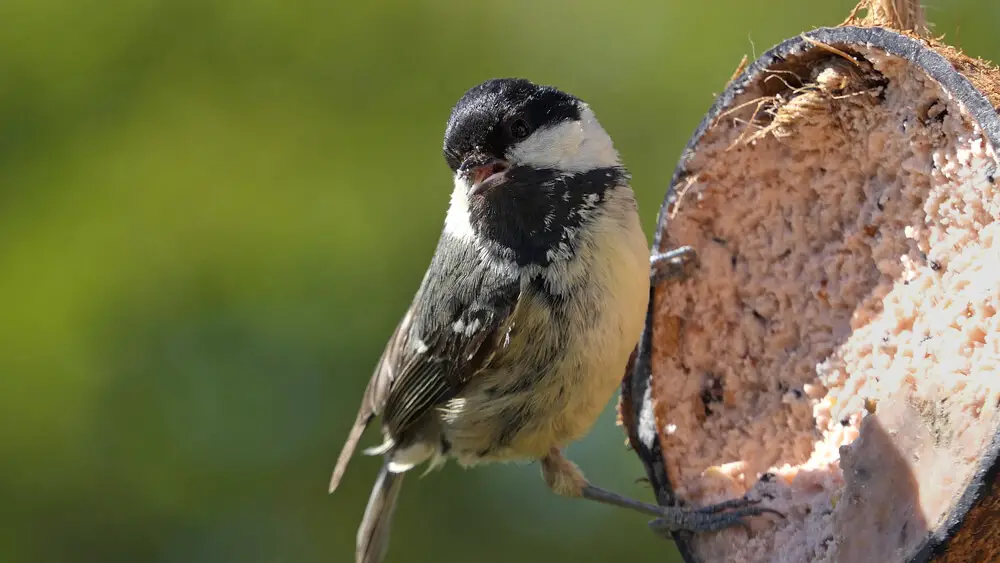Garden birds seem permanently busy. No sooner than chicks have flown the nest, it is time to concentrate on preparing for winter.
It is easy to feed the birds in the summer when we already spend much of our free time in the garden; you need to be dedicated to trudge out in the rain and snow to fill feeders.
The birds need our help at this time of year more than others; I’m sure they appreciate any supplementary feeding we offer.
If you’re keen to know what birds eat in autumn, keep reading.
As temperatures drop, birds need as much food as possible to give them enough energy to survive cold nights.
The colder it gets, the more difficult it becomes for them to find food in the wild. Many insects burrow deep to survive, and all the shoots and buds have long since gone.
Birds change their diet to autumn flowering buds and the insects that feed on their leaves. Holly, ivy, hawthorn, and honeysuckle are typical.
They also appreciate energy-providing suet, peanuts, seeds, and cereals that we put on the bird tables.
Table of Contents
Bird’s diets in the wild
Birds need to eat their own body weight every single day to stand any chance of surviving the cold. They need to eat a lot to create enough energy to hunt for food; it’s a vicious circle.
Autumn berries, seeds, are necessary for some birds; omnivorous ones also rely on insects, spiders, snails, and worms.
What to feed garden birds in autumn
Supplementary bird feeding is never more appreciated than in the autumn. There is a wide range of things that we can give them to provide much-needed energy and warmth.

Suet – Autumn is the best time to put fat balls, suet blocks or pellets in the garden. Home-made ones are even better as you can add extra healthy treats into the mixture.
Suet is high-calorie and nutritious, the perfect food to help birds survive cold nights. Mine seem to prefer the berry-flavoured pellets.
Peanuts – I always use bird-grade kibbled nuts for the birds; I worry about the choking hazard that whole nuts present.
Peanuts are calorific and provide the energy they need to hunt for food and roosting spots.
Tits, greenfinches, robins, house sparrows, and siskins are just some of the many peanut-lovers.
Soft and naturally dried fruits provide a nutritious snack for the birds in autumn. I find that any raisins and sultanas leftover from cake-making are gratefully received.
Mealworms – Insect-eating birds enjoy mealworms from the bird table or the ground. Live worms offer more nutrition than dried ones, but they’re better than nothing.
Cereal – Oat-based cereals, granola, and muesli are great to fill bird’s tummies as long as they’re sugar-free. They are small pieces of goodness that birds can eat quickly and easily.
Kitchen scraps – A few cake crumbs, a little grated cheese, or cooked rice and pasta are alternative energy-packed snacks for birds.
Try and clean feeders regularly to prevent disease; similarly, remove any uneaten food within a day or two.
Always provide fresh drinking water nearby; check daily to ensure it hasn’t frozen.
Planting to feed the birds in autumn
A clever way to feed the bird in autumn is to grow their favourite treats. It saves money, and you won’t need to continually replenish the bird table.
There is something to grow, even in a small garden or on a balcony.
Holly – the red berries of the holly bush are ripe and ready to eat by autumn. They are enjoyed by blackbirds, fieldfares, and redwings who feast on them well into winter.
Ivy – Insects are attracted to ivy leaves; where there are bugs, birds follow. Wrens and robins feast during autumn, but as winter approaches, the berries turn black and attract lots more species of songbirds.
Hawthorn – an excellent, long-term source of food as the hawthorn has berries until February and March. Chaffinches, starlings, greenfinches, and waxwings are some of the regular visitors.
Honeysuckle – A beautifully scented climbing plant ideal for pots or trailing over a doorway, arch, or balcony. The aroma attracts insects, food for the birds; the bushy leaves provide safe roosting spots. The berries are loved by thrushes, warblers, and bullfinches among others. Honeysuckle is a winner for autumn bird feeding.
Cotoneaster – Blackbirds, waxwings, and thrushes are some of the first birds to raid the red berries of the cotoneaster bush.
Sunflowers – As the petals fade, leave the flower to go to seed. The black shells attract many seed-eating birds such as long-tailed tits, finches, and nuthatches.

Great site. Really enjoyed your tips. My husband and I are also avid backyard bird watchers and I feed our Minnesota birds year round. This year we had an accidental sunflower garden (planted by the chipmunks – not me) and I’ve been amazed at the bird feeding activity. Even the hummingbirds visit them.
Again – great site. And Thanks. Keep up the good work.